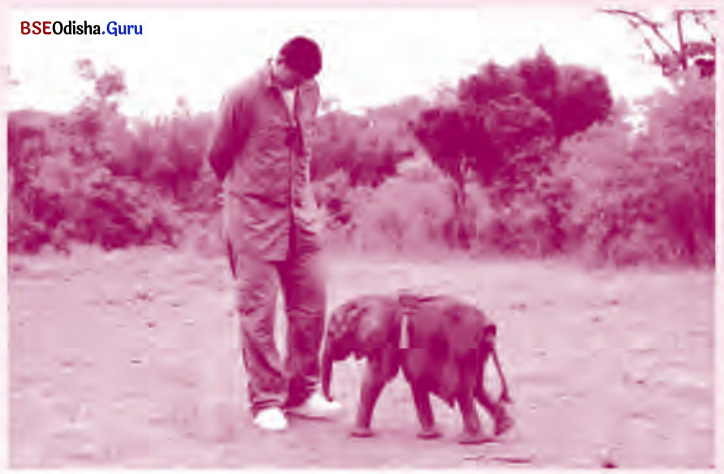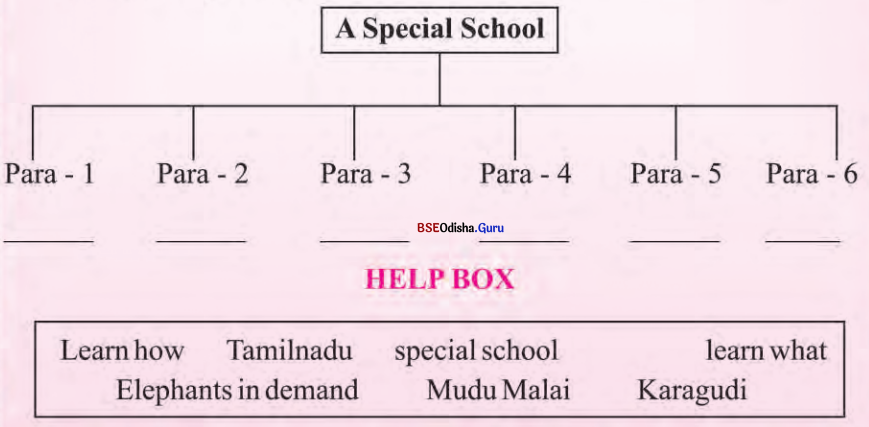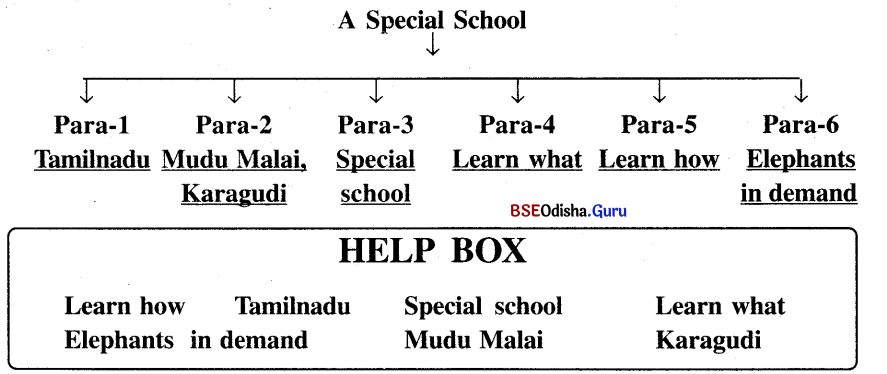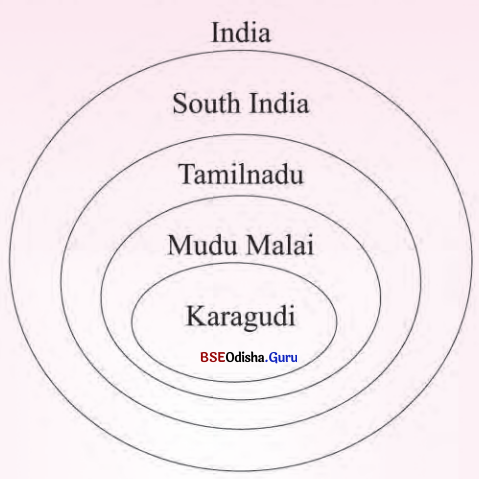Odisha State Board BSE Odisha 6th Class English Solutions Lesson 6 A Special School Textbook Exercise Questions and Answers.
Class 6th English Chapter 6 A Special School Question Answers BSE Odisha
A Special School Class 6 Questions and Answers
Session – 1
I. Pre-Reading
□ Teacher asks students to read the title of the lesson, see the pictures of elephants in the lesson, and answer the following questions.
(ଶିକ୍ଷକ ଶିକ୍ଷାର୍ଥୀମାନଙ୍କୁ ଗପଟିର ନାମ ପଢ଼ିବାକୁ, ବିଷୟରେ ଥିବା ହାତୀମାନଙ୍କର ଚିତ୍ର ଦେଖିବାକୁ ଏବଂ ନିମ୍ନଲିଖିତ ପ୍ରଶ୍ନଗୁଡ଼ିକର ଉତ୍ତର ଦେବାକୁ କୁହନ୍ତୁ ।)
- Who are the students in the special school?
(ସ୍ଵତନ୍ତ୍ର ବିଦ୍ୟାଳୟରେ ଛାତ୍ରଛାତ୍ରୀମାନେ କିଏ ?) - Who will be the teachers?
(କେଉଁମାନେ ଶିକ୍ଷକ ହେବେ ?) - Can you guess what the baby elephants will learn in school?
(ତୁମେ ଅନୁମାନ କରପାରିବ କି ହାତୀ ଛୁଆମାନେ ବିଦ୍ୟାଳୟରେ କ’ଣ ଶିଖିବେ ?) - Will there be punishment for the students (the baby elephants) if they do not learn?
( ଯଦି ଛାତ୍ରଛାତ୍ରୀମାନେ (ହାତୀ ଛୁଆମାନେ) ଅଧ୍ୟୟନ ନକରନ୍ତି ସେମାନଙ୍କ ପାଇଁ ଦଣ୍ଡ ରହିବ କି ?) - Where should be the school? Should there be classrooms with walls?
(କେଉଁଠାରେ ବିଦ୍ୟାଳୟ ହେବା ଉଚିତ ? ସେଠାରେ କାନ୍ଥଗୁଡ଼ିକ ଘେରା ହେଉଥିବା ଶ୍ରେଣୀକୋଠରି ସବୁ ରହିବା ଉଚିତ କି ?)
![]()
II. While-Reading
Text
SGP-l
Read paragraphs 1-2 silently and answer the questions that follow.
(ଅନୁଚ୍ଛେଦ ୧ – ୨ କୁ ନୀରବରେ ପଢ଼ ଏବଂ ପରବର୍ତ୍ତୀ ପ୍ରଶ୍ନଗୁଡ଼ିକର ଉତ୍ତର ଦିଅ ।)
1. Tamilnadu is a beautiful state. It has beautiful mountain ranges and valleys. Inside these mountain ranges, there are many rivers. Some of these rivers flow through the valleys. This makes these places all the more beautiful.
2. One of the mountain ranges is Mudu Malai. At the feet of this mountain range there is a plain land. This plain range is called Karagudi, All around Karagudi, there are thick forests. A river flows across Karagudi which makes the place very very beautiful.
ଓଡ଼ିଆ ଅନୁବାଦ :
୧. ତାମିଲନାଡୁ ଗୋଟିଏ ସୁନ୍ଦର ରାଜ୍ୟ । ଏହାର ସୌନ୍ଦର୍ଯ୍ୟପୂର୍ଣ୍ଣ ପର୍ବତଶ୍ରେଣୀଗୁଡ଼ିକ ଏବଂ ଉପତ୍ୟକାମାନ ଅଛି । ଏହି ପର୍ବତଶ୍ରେଣୀର ଭିତରେ, ଅନେକ ନଦୀ ଅଛନ୍ତି । ଏହି ନଦୀମାନଙ୍କ ମଧ୍ୟରୁ କେତେକ ଉପତ୍ୟକା ମଧ୍ୟରେ ପ୍ରବାହିତ ହୋଇଛନ୍ତି । ଏହା ଏହି ସ୍ଥାନଗୁଡ଼ିକୁ ଆହୁରି ଅଧିକ ସୁନ୍ଦର କରିଅଛି ।
୨. ପର୍ବତ ଶ୍ରେଣୀଗୁଡ଼ିକ ମଧ୍ୟରୁ ଗୋଟିଏ ହେଉଛି ମୁଦୁ ମାଲାଇ । ଏହି ପର୍ବତର ପାଦଦେଶରେ ଗୋଟିଏ ସମତଳଭୂମି ଅଛି । ଏହି ସମତଳଭୂମିକୁ କୁହାଯାଏ କାରାଗୁଡ଼ି । କାରାଗୁଡ଼ିର ଚାରିଆଡ଼େ ଘଞ୍ଚ ଜଙ୍ଗଲ ସବୁ ଅଛି । ଗୋଟିଏ ନଦୀ କାରାଗୁଡ଼ିକୁ ଅତିକ୍ରମ କରି ବୋହିଯାଉଛି ଯାହା ଏହି ସ୍ଥାନକୁ ବହୁତ ବହୁତ ସୁନ୍ଦର କରିଦେଇଛି ।
Comprehension Questions
Question 1.
The writer talks about three places in this part of the lesson. What are they?
(ଲେଖକ ଗପର ଏହି ଅଂଶରେ ତିନୋଟି ସ୍ଥାନ ବିଷୟରେ କହିଛନ୍ତି । ସେଗୁଡ଼ିକ କ’ଣ ଅଟନ୍ତି ?)
Answer:
They are Tamilnadu, Mudu Malai and Karagudi.
Question 2.
What makes Tamilnadu beautiful?
(ତାମିଲନାଡୁକୁ କ’ଣ ସୌନ୍ଦର୍ଯ୍ୟପୂର୍ଣ୍ଣ କରିଛି ?)
Answer:
The beautiful mountain ranges, valleys and many rivers make Tamilnadu more beautiful.
Question 3.
What is Mudu Malai?
(ମୁଦ୍ର ମାଲାଇ କ’ଣ ଅଟେ ?)
Answer:
Mudu Malai is a mountain range in Tamilnadu.
Question 4.
Where is Karagudi?
(କାରାଗୁଡ଼ି କେଉଁଠାରେ ଅବସ୍ଥିତ ?)
Answer:
Karagudi, a plain land, is at the feet of Mudu Malai mountain range.
Question 5.
What makes Karagudi beautiful?
(କାରାଗୁଡ଼ିକୁ କ’ଣ ସୁନ୍ଦର କରିଛି ?)
Answer:
Thick forests all around Karagudi and a river flowing across it makes the place very very beautiful.
![]()
SGP-2
Read paragraphs 3-4 silently and answer the questions that follow.
(ଅନୁଚ୍ଛେଦ ୩ – ୪ କୁ ନୀରବରେ ପଢ଼ି ପରବର୍ତ୍ତୀ ପ୍ରଶ୍ନଗୁଡ଼ିକର ଉତ୍ତର ଦିଅ ।)

3. There is a special school in Karagudi. It is special because it is not for children. Can you guess for whom it is? It is for baby elephants. Who teaches them? The elephant trainers teach them. Like our schools, they have a timetable. They learn, play, and eat according to this timetable. Baby elephants are like children, sometimes good and sometimes naughty.
4. What do baby elephants learn in this special school? Baby elephants learn some words. For example, when the trainer says ‘jo-jo’, they come out of the water. They learn how to salute. They also learn how to ring the bell of the temple. They also learn to offer flowers to God.
ଓଡ଼ିଆ ଅନୁବାଦ :
୩. କାରାଗୁଡ଼ିରେ ଏକ ସ୍ଵତନ୍ତ୍ର ବିଦ୍ୟାଳୟ ଅଛି । ଏହା ସ୍ବତନ୍ତ୍ର କାରଣ ଏହା ଛୋଟପିଲାଙ୍କ ପାଇଁ ଉଦ୍ଦିଷ୍ଟ ନୁହେଁ । ଏହା କେଉଁମାନଙ୍କ ପାଇଁ ତୁମେ ଅନୁମାନ କରିପାରିବ କି ? ଏହା ହାତୀଛୁଆମାନଙ୍କ ପାଇଁ ଉଦ୍ଦିଷ୍ଟ । ସେମାନଙ୍କୁ କିଏ ପଢ଼ାନ୍ତି ? ହାତୀ ତାଲିମ୍ଦାତାମାନେ ସେମାନଙ୍କୁ ପଢ଼ାନ୍ତି । ଆମ ବିଦ୍ୟାଳୟଗୁଡ଼ିକ ପରି, ସେମାନଙ୍କର ସମୟ ନିର୍ଘଣ୍ଟ (ରୁଟିନ୍) ଅଛି । ସେମାନେ ସମୟ ନିର୍ଘଣ୍ଟ (ରୁଟିନ୍) ଅନୁଯାୟୀ ଶିଖନ୍ତି, ଖେଳନ୍ତି ଓ ଖାଆନ୍ତି । ହାତୀଛୁଆମାନେ ଶିଶୁମାନଙ୍କ ପରି, ବେଳେବେଳେ ଭଲ ଓ ବେଳେବେଳେ ଦୁଷ୍ଟ (ଅବାଧ୍ଯ) ହୋଇଥା’ନ୍ତି ।
୪. ହାତୀଛୁଆମାନେ ଏହି ସ୍ବତନ୍ତ୍ର ବିଦ୍ୟାଳୟରେ କ’ଣ ଶିଖନ୍ତି ? ହାତୀଛୁଆମାନେ କେତେକ ଶବ୍ଦ ଶିଖନ୍ତି । ଉଦାହରଣସ୍ୱରୂପ, ଯେତେବେଳେ ହାତୀ ତାଲିମ୍ଦାତା କହନ୍ତି, ‘ଜୋ-ଜୋ’, ସେମାନେ ପାଣି ବାହାରକୁ ଆସନ୍ତି । ସେମାନେ ଶିଖନ୍ତି କିପରି ନମସ୍କାର (ସଲାମ୍) କରିବାକୁ ହେବ । ସେମାନେ ମଧ୍ୟ ଶିଖନ୍ତ ମନ୍ଦିରରେ କିପରି ପୂଜା କରିବାକୁ ହେବ । ସେମାନେ ଶିଖନ୍ତି କିପରି ମନ୍ଦିରର ଘଣ୍ଟି ବଜାଇବାକୁ ହେବ । ସେମାନେ ମଧ୍ୟ ଠାକୁରଙ୍କୁ ଫୁଲସବୁ ଅର୍ପଣ କରିବାକୁ ଶିଖିଥା’ନ୍ତି ।
Comprehension Questions
Question 1.
What are these paragraphs about?
(ଏହି ଅନୁଚ୍ଛେଦଗୁଡ଼ିକ କେଉଁ ବିଷୟ ବର୍ଣ୍ଣନା କରୁଛନ୍ତି ?)
Answer:
These paragraphs are about the special school for baby elephants in Karagudi and different things they learn in that school.
Question 2.
Why is this school special?
(ଏହି ବିଦ୍ୟାଳୟ କାହିଁକି ସ୍ବତନ୍ତ୍ର ଅଟେ ?)
Answer:
This school is special because it is not for children.
Question 3.
Who are the students?
(କେଉଁମାନେ ଛାତ୍ର ଅଟନ୍ତି ?)
Answer:
Baby elephants are the students in the special school.
Question 4.
Who are the teachers?
(କେଉଁମାନେ ଶିକ୍ଷକ ଅଟନ୍ତି ?)
Answer:
The elephant trainers are the teachers in the special school.
Question 5.
Do they have a timetable like us? How do they follow it?
(ସେମାନଙ୍କର ଆମ ପରି ସମୟ ନିର୍ଘଣ୍ଟ (ରୁଟିନ୍) ଅଛି କି ? ସେମାନେ ଏହାକୁ କିପରି ଅନୁସରଣ କରନ୍ତି ?)
Answer:
Yes, they have a time-table like us. According to this time-table, they learn, play and eat in the special school.
![]()
Question 6.
What do they learn?
(ସେମାନେ କ”ଣ ଶିଖିଥା’ନ୍ତି ?)
Answer:
Baby elephants learn some words. For example, when the trainer says, ‘jo-jo’ they come out of water. They learn how to salute. They also learn how to perform puja in a temple.
Question 7.
What do they learn to perform puja?
(ପୂଜା କରିବାକୁ ସେମାନେ କ’ଣ ଶିଖନ୍ତି ?)
Answer:
They learn how to ring the bell of the temple. They also learn to offer flowers to God. In this way, they learn how to perform puja.
Session – 2
SGP-3
• Read paragraphs 5-6 silently and answer the questions that follow.
(ଅନୁଚ୍ଛେଦ ୫ — ୬ କୁ ନୀରବରେ ପଢ଼ ଏବଂ ପରବର୍ତ୍ତୀ ପ୍ରଶ୍ନଗୁଡ଼ିକର ଉତ୍ତର ଦିଅ ।)

5. How do these baby elephants learn all these ? Mainly through instructions, praises and punishment. Learning starts from food. Elephants are fond of banana and sugarcane. The trainer raises a piece of sugarcane over the head of a baby elephant. The baby elephant raises its head to eat the sugarcane. At this time the trainer says ‘salam’. He does this many a time. In this way the baby elephant learns to raise its head when the trainer says ‘salam’ without giving sugarcane. The baby elephants are praised and given food when they act according to instructions. If they do not, they are punished.
6. The Karagudi trained elephants are in great demand. The circus people need them. In circus shows, the trained elephants salute, ride bicycle and dance to music. The temple people need them. The cinema people also need them to act in films. One such very popular film is “Hathi Mera Sathi”.
ଓଡ଼ିଆ ଅନୁବାଦ :
୫. କିପରି ଏହି ହାତୀଛୁଆମାନେ ଏସବୁ ଶିଖନ୍ତି । ମୁଖ୍ୟତଃ, ନିର୍ଦ୍ଦେଶ, ପ୍ରଶଂସା ଏବଂ ଦଣ୍ଡ ମାଧ୍ୟମରେ ସେମାନେ ଶିଖିଥା’ନ୍ତି । ଖାଦ୍ୟରୁ ଶିଖିବା ଆରମ୍ଭ ହୁଏ । ହାତୀମାନେ କଦଳୀ ଓ ଆଖୁ ପ୍ରିୟ । ହାତୀ ତାଲିମଦାତା ଖଣ୍ଡେ ଆଖୁକୁ ହାତୀଛୁଆର ମୁଣ୍ଡ ଉପରେ ଟେକି ଧରେ । ହାତୀଛୁଆ ଆଖୁ ଖାଇବାକୁ ଏହାର ମୁଣ୍ଡ ଉଠାଏ । ଏହି ସମୟରେ ତାଲିମଦାତା କହେ ‘ସଲାମ୍’ । ସେ ଏହି କାର୍ଯ୍ୟ ଅନେକଥର କରେ । ଏହିପରି ଭାବେ ଯେତେବେଳେ ତାଲିମ୍ତା ଆଖୁ ନଦେଇ ମଧ୍ୟ ‘ସଲାମ୍’ କହନ୍ତି ହାତୀଛୁଆ ମୁଣ୍ଡ ଉପରକୁ ଉଠାଇବାକୁ ଶିଖେ । ହାତୁଛୁଆମାନଙ୍କୁ ପ୍ରଶଂସା କରାଯାଏ ଏବଂ ଖାଦ୍ୟ ଦିଆଯାଏ ଯେତେବେଳେ ସେମାନେ ନିର୍ଦ୍ଦେଶ ଅନୁସାରେ କାର୍ଯ୍ୟ କରନ୍ତି । ଯଦି ସେମାନେ ନ କରନ୍ତି, ସେମାନଙ୍କୁ ଦଣ୍ଡ ଦିଆଯାଏ ।
୬. କାରାଗୁଡ଼ିରେ ତାଲିମ୍ ନେଇଥିବା ହାତୀମାନଙ୍କର ବହୁତ ଚାହିଦା ରହିଛି । ସର୍କସ୍ ଲୋକେ ସେମାନଙ୍କୁ ଦରକାର କରିଥା’ନ୍ତି । ସର୍କସ୍ ଖେଳରେ ତାଲିମୂପ୍ରାପ୍ତ ହାତୀମାନେ ସାଲ୍ୟୁଟ୍ ମାରନ୍ତି (ନମସ୍କାର କରନ୍ତି), ସାଇକେଲ୍ ଚଢ଼ନ୍ତି, ସଙ୍ଗୀତ ଅନୁସାରେ ନାଚନ୍ତି । ମନ୍ଦିର ଲୋକେ ସେମାନଙ୍କୁ ଦରକାର କରନ୍ତି । ସିନେମା (ଚଳଚ୍ଚିତ୍ର) ଲୋକେ ମଧ୍ୟ ସେମାନଙ୍କୁ ଦରକାର କରନ୍ତି ଫିଲ୍ମରେ (ଚଳଚ୍ଚିତ୍ରରେ) ଅଭିନୟ କରିବାକୁ । ‘‘ହାଥୀ ମୋର ସାଥୀ’’ ଏହିପରି ଏକ ଜନପ୍ରିୟ ଚଳଚ୍ଚିତ୍ର ଅଟେ ।
![]()
Comprehension Questions
Question 1.
What is paragraph 5 about? (What they iearn or how they learn)
(ଅନୁଚ୍ଛେଦ – ୫ କେଉଁ ବିଷୟରେ ବର୍ଣ୍ଣନା କରିଛି ?) (ସେମାନେ କ’ଣ ଶିଖନ୍ତି ଓ କିପରି ଶିଖନ୍ତି ?)
Answer:
Paragraph 5 is about how the baby elephant learns to ‘salam’ by the elephant trainer. (Or) Paragraph 5 is about what the baby elephants learn and how they learn.
Question 2.
Where does every lesson start from?
(କେଉଁଠାରେ ପ୍ରତ୍ୟେକ ଶିକ୍ଷା ଆରମ୍ଭ ହୁଏ ?)
Answer:
Every lesson starts from food.
Question 3.
What are elephants fond of ?
(ହାତୀମାନଙ୍କର କ’ଣ ପ୍ରିୟ ଅଟେ ?)
Answer:
Elephants are fond of bananas and sugarcane.
Question 4.
What does the baby elephant do when the trainer raises a sugarcane?
(ଯେତେବେଳେ ତାଲିମ୍ତା ଖଣ୍ଡେ ଆଖୁ ଉଠାନ୍ତି, ହାତୀ ଛୁଆଟି କ’ଣ କରେ ?)
Answer:
When the trainer raises a sugarcane the baby elephant raises its head to eat the sugarcane.
Question 5.
Then what does the trainer say ?
(ସେତେବେଳେ ତାଲିମଦାତା କ’ଣ କହନ୍ତି ?)
Answer:
Then the trainer says ‘salam’.
![]()
Question 6.
What is given to the baby elephants if they follow the instructions?
(ଯଦି ହାତୀଛୁଆମାନେ ନିର୍ଦେଶଗୁଡ଼ିକୁ ଅନୁସରଣ କରନ୍ତି ସେମାନଙ୍କୁ କ’ଣ ଦିଆଯାଏ ?)
Answer:
The baby elephants are praised and given food if they follow the instructions.
Question 7.
If they don’t follow,
Answer:
If they don’t follow, they are punished.
Question 8.
What is paragraph 6 about?
(ଅନୁଚ୍ଛେଦ ୬ କେଉଁ ବିଷୟରେ ବର୍ଣ୍ଣନା କରିଛି ?)
Answer:
The paragraph 6 is about the great demand of the Karagudi trained elephants.
Question 9.
Who needs Karagudi trained elephants?
(କାରାଗୁଡ଼ିର ତାଲିମ୍ପ୍ରାପ୍ତ ହାତୀମାନଙ୍କୁ କିଏ ଦରକାର କରନ୍ତି ?)
Answer:
The circus people, the temple people and the cinema people need Karagudi trained elephants.
Question 10.
What do the trained elephants do in the circus?
(ସର୍କସ୍ରେ ତାଲିମୂପ୍ତ ହାତୀମାନେ କ’ଣ କରନ୍ତି ?)
Answer:
In circus shows, the trained elephants salute, ride bicycles, and dance to music.
Question 11.
What is the name of the film in which an elephant played an important role?
(ଯେଉଁ ଚଳଚ୍ଚିତ୍ରରେ ଏକ ହାତୀ ମୁଖ୍ୟ ଭୂମିକାରେ ଅଭିନୟ କରିଛି, ସେହି ଚଳଚ୍ଚିତ୍ରର ନାମ କ’ଣ ?)
Answer:
The name of the popular film is ‘Hathi Mera Sathi’ in which an elephant has played an important role.
![]()
Session – 3
III. Post-Reading
1. Visual Memory Development Technique (VMDT):
(ଦୃଶ୍ୟ ସ୍ମ ତି ଉନ୍ନୟନ କୌଶଳ (VMDT))
Whole Text:
Description of places, special school, training of baby elephants, what the trained elephants do
Part of the text:
Tamilnadu, Mudu Malai, special school, trainers, timetable, river, banana, sugarcane, puja, circus, film.
2. Comprehension Activities
(a)Summarizing:
The teacher draws the following diagram on the blackboard and fills in the information given by students.

Answer:

![]()
Session – 4
(b) MCQs: Choose the correct options and fill in the blanks.
Question 1.
The special school at Karagudi is for ______________?
(A) tigers
(B) elephants
(C) lions
(D) monkeys
Answer:
(B) elephants
Question 2.
Trainers teach the elephants using?
(A) mango
(B) orange
(C) sugarcane
(D) sweets
Answer:
(C) sugarcane
Question 3.
When the trainer says, the elephants come out of the water?
(A) salam
(B) ho-ho
(C) jo-jo
(D) bho-bho
Answer:
(C) jo-jo
Question 4.
Trained elephants cannot ________________?
(A) climb trees
(B) pull huge logs of wood
(C) work in circus
(D) act in films
Answer:
(A) climb trees
3. Listening
The teacher will read aloud the last paragraph of the text slowly. Students listen and fill in the blanks.
(ବିଷୟବସ୍ତୁର ଶେଷ ଅନୁଚ୍ଛେଦକୁ ଶିକ୍ଷକ ବଡ଼ପାଟିରେ ଧୀରେ ଧୀରେ ପଢ଼ିବେ । ଶିକ୍ଷାର୍ଥୀମାନେ ମନଦେଇ ଶୁଣିବେ ଓ ଶୂନ୍ୟସ୍ଥାନଗୁଡ଼ିକୁ ପୂରଣ କରିବେ ।)
(Question with Answer)
The Karagudi-trained elephants are in great demand. The circus people need them. In circus shows, the trained elephants salute, ride bicycles, and dance to music. The cinema people need them to act in films.
![]()
Session – 5
4. Speaking
(a) Practice the following dialogues.
(ନିମ୍ନଲିଖ ସଂଳାପଗୁଡ଼ିକୁ ଅଭ୍ୟାସ କର ।)
Steps:
- Teacher reads aloud the dialogues, students listen.
(ଶିକ୍ଷକ ବଡ଼ପାଟିରେ ସଂଳାପଗୁଡ଼ିକୁ ପଢ଼ିବେ, ଶିକ୍ଷାର୍ଥୀମାନେ ମନଦେଇ ଶୁଣିବେ ।)
- Teacher reads aloud one sentence, students repeat after him / her.
(ଶିକ୍ଷକ ବଡ଼ପାଟିରେ ଗୋଟିଏ ବାକ୍ୟ ପଢ଼ିବେ, ଶିକ୍ଷାର୍ଥୀମାନେ ଏହାକୁ ତାଙ୍କ ପରେ ପୁନରାବୃତ୍ତି କରିବେ ।)
- Role-play
(Let the students see the text and read aloud the dialogue)
( ଛାତ୍ରମାନେ ବିଷୟବସ୍ତୁଟିକୁ ଦେଖନ୍ତୁ ଏବଂ ସଂଳାପକୁ ବଡ଼ପାଟିରେ ପଢ଼ନ୍ତୁ)
– Teacher vs. students (ଶିକ୍ଷକ ବନାମ ଶିକ୍ଷାର୍ଥୀମାନେ )
– Students vs. students ( ଶିକ୍ଷାର୍ଥୀମାନେ ବନାମ ଶିକ୍ଷାର୍ଥୀମାନେ)
– Students vs. student (ଶିକ୍ଷାର୍ଥୀମାନେ ବନାମ ଶିକ୍ଷାର୍ଥୀ)
Ramesh : I’m Rajesh. I’m from Odisha.
Vasudevan : I’m Vasudevan. I’m from Tamilnadu.
Ramesh : Where in Tamilnadu’?
Va.sudevan : Karagudi.
Ramesh : 0 Karagudi ! The name sounds popular.
Vasudevan : 0 yes. It’s famous for the Elephant School.
Ramesh : Have you ever visited the school?
Vasudevan : Many a time!
Ramesh : What do the elephants learn?
Vasudevan : They learn to salute, perform puja, ride bicycles and many more.
Ramesh : Do they get reward for good work ?
Vasudevan : Yes, when they do something well, they are given sweets, sugarcane or bananas.
Ramesh : And if they fail to do something well ?
Vasudevan : In that case, they get no reward. That’s the punishment.
Ramesh : That is wonderful !
Vasudevan : Sorry. My mother is calling me. Bye.
Ramesh : Thanks ! Bye !
(b) In English there are some words with ‘ee\ ‘ea’ or ‘oo\ ‘ie’ in their spelling. We take a long time to speak them out. Given below are some such words. Your teacher will say these words one after another. Repeat after him/her. Then add some more words to the list.
(ଇଂରାଜୀରେ କେତେଗୁଡ଼ିଏ ଶବ୍ଦ ଅଛି ଯାହାର ସେମାନଙ୍କ ବନାନରେ ‘ee’ ‘ea” or ‘oo’ ‘ie’ ଥାଏ । ଆମେ ସେଗୁଡ଼ିକୁ କହିବା ବେଳେ ଅଧିକ ସମୟ ନେଇଥାଉ । ନିମ୍ନରେ ଏପରି କେତେକ ଶବ୍ଦ ଦିଆଯାଇଛି । ତୁମ ଶିକ୍ଷକ ଏହି ଶବ୍ଦଗୁଡ଼ିକୁ ଗୋଟିକ ପରେ ଗୋଟିଏ କହିବେ । ତାଙ୍କ (ପୁ/ସ୍ତ୍ରୀ) ପଛରେ ତୁମେ ଏଗୁଡ଼ିକ ପୁନରାବୃତ୍ତି କର । ତା’ପରେ ଅଧୂକ କିଛି ଶବ୍ଦ ଏହି ତାଲିକାରେ ଯୋଡ଼ ।)
| ee | oo | ea | ie |
| green | fool | teacher | piece |
| need | food | eat | belief |
| feet | school | seat | relief |
Answer:
| teeth | tooth | beat | chief |
| sheep | foot | clean | grief |
| keep | moon | neat | pierce |
![]()
Session – 6
5. Vocabulary:
(a) Read paragraph – 1 of the lesson and watch the following words. There is another word inside in each of them. The words are underlined.
(ବିଷୟବସ୍ତୁର ଅନୁଚ୍ଛେଦ – ୧ ପଢ଼ ଏବଂ ନିମ୍ନଲିଖିତ ଶବ୍ଦଗୁଡ଼ିକୁ ଦେଖ । ସେମାନଙ୍କ ମଧ୍ୟରୁ ପ୍ରତ୍ୟେକ ମଧ୍ୟରେ ଆଉ ଗୋଟିଏ ଶବ୍ଦ ଅଛି । ସୈହ ଶବ୍ଦଗୁଡ଼ିକୁ ଗାର ପକାଇ ଦିଆଯାଇଛି ।)
State Forest Mountain Clear
Now read paragraph 3 and find words inside words in the list below. (Question with Answer)
(ବର୍ତ୍ତମାନ ଅନୁଚ୍ଛେଦ – ୩ କୁ ପଢ଼ ଏବଂ ନିମ୍ନ ତାଲିକାରେ ଥିବା ଶବ୍ଦଗୁଡ଼ିକ ଭିତରେ ଥିବା ଶବ୍ଦଗୁଡ଼ିକୁ ଖୋଜି ବାହାର କର ।)

Answer:
teach = tea, each
because = be, cause, use
children = child
there = the, here
training = train, raining
understand = under, stand, and
sugarcane = sugar, cane, arc, can
Session – 7
(b) Make a word chain. Use the last letter of a word as the first letter of the next word, for example-
(ଶବ୍ଦ ଶୃଙ୍ଖଳ ଗଠନ କର । ଗୋଟିଏ ଶବ୍ଦର ଶେଷ ଅକ୍ଷରକୁ ପରବର୍ତ୍ତୀ ଶବ୍ଦର ପ୍ରଥମ ଅକ୍ଷର ଭାବେ ବ୍ୟବହାର କର, ଉଦାହରଣ ସ୍ବରୂପ –)
SUGARCANE > EAT > TIMETABLE > ELEPHANT > TRAINING > GOOD
Add more words to complete the chain of the three lines.
(ତିନିଧାଡ଼ିର ଶୃଙ୍ଖଳଟିକୁ ସମ୍ପୂର୍ଣ୍ଣ କରିବାକୁ ଅଧିକ ଶବ୍ଦ ଯୋଗକର ।)
Answer:
DOOR > RAIN > NINE > EGG > GO > ORANGE > EAR > ROOF > FIRE > EIGHT > TEN > NOON > NIGHT > TIN > NEAR > ROAD > DOG > GOD > DEAR > RIGHT > TEMPLE > EIGHTY > YELLOW
(c) Some words from your lesson are described below. Figures in brackets show paragraph numbers in the text. Find the words and write them in the blanks.
(ତୁମ ବିଷୟର କେତେକ ଶବ୍ଦ ନିମ୍ନରେ ବର୍ଣ୍ଣନା କରାଯାଇଛି । ବନ୍ଧନୀ ମଧ୍ୟରେ ଥିବା ଶବ୍ଦ ବିଷୟର ଅନୁଚ୍ଛେଦ କ୍ରମାଙ୍କକୁ ସୂଚାଉଅଛି । ଶବ୍ଦଗୁଡ଼ିକୁ ଖୋଜ ଓ ସେଗୁଡ଼ିକୁ ଶୂନ୍ୟସ୍ଥାନରେ ଲେଖ ।)
Students go there the study. (3) —
Teacher of elephants. (3) —
An elephant does it by raising its trunk. (5) —
A place of worship. (4) —
A big animal with a trunk. (4) —
Children are sometimes good and sometimes like this. (3) —
A large area covered with trees. (1) —
Work schedule. (3) —
A tall plant with a sweet stem. (5) —
Answer:
(i) school,
(ii) elephant trainer,
(iii) salam,
(iv) temple,
(v) elephant,
(vi) naughty,
(vii) forest,
(viii) timetable,
(ix) sugarcane.
![]()
Session – 8
6. Usage
Look at the underlined parts in the sentences.
(ବାକ୍ୟଗୁଡ଼ିକର ତଳେ ଗାର ପଡ଼ିଥିବା ଅଂଶକୁ ଦେଖ ।)
- They learn how to salute.
- They leam how to perform puja in the temple.
These sentences can be written as :
- They leam how they should salute.
- They also know how they should perform puja in the temple.
“How to” is written as “how + the doer + should”
Rewrite the following sentences using “how to” in place of how should. One is done for you.
(ଆଉ ଥରେ ‘how………..should? ବଦଳରେ “‘how to’’ ବ୍ୟବହାର କରି ବାକ୍ୟଗୁଡ଼ିକୁ ଲେଖ । ଗୋଟିଏ ତୁମ ପାଇଁ କରି ଦିଆଯାଇଛି ।)
Question (i)
Elephants are taught how they should salute.
Answer:
Elephants are taught how to salute.
Question (ii)
A trained elephant knows how he should act in films.
Answer:
A trained elephant knows how to act in films.
Question (iii)
A pilot is trained on how he should fly an aeroplane.
Answer:
A pilot is trained on how to fly an aeroplane.
Question (iv)
A fisherman knows how he should fish in a deep river.
Answer:
A fisherman knows how to fish in a deep river.
Question (v)
A doctor has learnt how he should treat serious patients.
Answer:
A doctor has learnt how to treat serious patients.
Question (vi)
Baby elephants are taught how they should play tricks in the circus.
Answer:
Baby elephants are taught how to play tricks in the circus.
![]()
Session – 9
7. Writing
(a) See the diagram and do the following activities. (Question with Answer)
(ଚିତ୍ରଟିକୁ ଦେଖ ଏବଂ ନିମ୍ନଲିଖିତ କାର୍ଯ୍ୟଗୁଡ଼ିକ କର ।)

(i) Karagudi is in Mudu Malai.
(ii) Mudu Malai is in Tamilnadu.
(iii) Tamilnadu is in South India.
(iv) The South India is in India.
Now write beginning with India. (Question with Answer)
(ବର୍ତ୍ତମାନ India କୁ ଆରମ୍ଭରେ ରଖି ଲେଖ ।)
(i) Inside India is South India.
(ii) Inside South India is Tamilnadu.
(iii) Inside Tamilnadu is Mudu Malai.
(iv) Inside Mudu Malai is Karagudi.
(b)Answer the following questions in one sentence each. (Half of the answer you get from the question itself and half from the text.)
(ନିମ୍ନଲିଖ ପ୍ରଶ୍ନଗୁଡ଼ିକର ଉତ୍ତର ପ୍ରତ୍ୟେକକୁ ଗୋଟିଏ ଲେଖାଏଁ ବାକ୍ୟରେ ଦିଅ । (ତୁମେ ଅଧା ଉତ୍ତର ପ୍ରଶ୍ନରୁ ଓ ଅଧା ଉତ୍ତର ବିଷୟବସ୍ତୁରୁ ପାଇଯିବ ।)
![]()
Question (i)
Why is the school called a special school?
(କାହିଁକି ବିଦ୍ୟାଳୟଟିକୁ ଏକ ସ୍ଵତନ୍ତ୍ର ବିଦ୍ୟାଳୟ କୁହାଯାଏ ?)
Answer:
The school is called a special school because it is not for children.
Question (ii)
Who are the students there?
(ସେଠାରେ କେଉଁମାନେ ଛାତ୍ର ଅଟନ୍ତି ?)
Answer:
There the students are the baby elephants.
Question (iii)
Who teaches there?
(କିଏ ସେଠାରେ ପଢ଼ାନ୍ତି ?)
Answer:
The elephant trainer teaches there.
Question (iv)
Where is the school?
(କେଉଁଠାରେ ବିଦ୍ୟାଳୟଟି ଅବସ୍ଥିତ?)
Answer:
The school is in Karagudi.
Question (v)
Where is Karagudi?
(କାରାଗୁଡ଼ି କେଉଁଠାରେ ?)
Answer:
Karagudi is in Mudu Malai.
Question (vi)
How do elephants salute?
(ହାତୀମାନେ କିପରି ସାଲ୍ୟୁଟ୍ କରନ୍ତି ?)
Elephants ___________by ___________raising
Answer:
Elephants salute by raising their heads.
Question (vii)
How do elephants perform puja?
(ହାତୀମାନେ କିପରି ପୂଜା କରନ୍ତି ?)
Answer:
Elephants perform puja by ringing the bell of the temple and offering flowers to God.
Question (viii)
What work do elephants learn to do?
(ହାତୀମାନେ କେଉଁ କାମ କରିବାକୁ ଶିଖନ୍ତି ?)
Answer:
Elephants learn how to salute and how to perform puja in a temple.
Question (ix)
What do elephants learn to do for circus?
(ହାତୀମାନେ ସର୍କସ୍ରେ କ’ଣ କରିବାକୁ ଶିଖନ୍ତି ?)
Answer:
Elephants learn to salute, ride bicycles, and dance to music in the circus.
![]()
Session – 10
(c) Answer the following questions.
(ନିମ୍ନଲିଖ ପ୍ରଶ୍ନଗୁଡ଼ିକର ଉତ୍ତର ଦିଅ ।)
Question (i)
Write 5 sentences about the school. (This answer can be done by putting together the answers to questions 1 – 5.)
( ବିଦ୍ୟାଳୟ ବିଷୟରେ ୫ଟି ବାକ୍ୟ ଲେଖ । (ପ୍ରଶ୍ନ ୧ – ୫ ର ଉତ୍ତରକୁ ଏକତ୍ର କରି ଏହି ଉତ୍ତର କରିହେବ ।))
Answer:
There is a special school in Karagudi. It is special because it is not for children. It is for baby elephants. The elephant trainers teach them. Like our schools, they have a timetable. They learn, play, and eat according to this timetable.
Question (ii)
What do elephants learn in a special school?
(ହାତୀମାନେ ସ୍ବତନ୍ତ୍ର ବିଦ୍ୟାଳୟରେ କ’ଣ ଶିଖନ୍ତି ?)
Answer:
In special schools, elephants learn some words. For example, when the trainer says “jo-jo”, they come out of the water. They learn how to salute. They also learn how to perform puja in a temple. For example, they learn how to ring the bell of the temple. They also learn to offer flowers to God.
Question (iii)
Write how the baby elephants learn at the special school. (Part-5)
(ହାତୀଛୁଆମାନେ ସ୍ବତନ୍ତ୍ର ବିଦ୍ୟାଳୟରେ କିପରି ଶିକ୍ଷାଗ୍ରହଣ କରନ୍ତି ଲେଖ ।)
Answer:
At the special school, the baby elephants learn everything from the elephant trainers mainly through instructions, praises, and punishment. Learning starts with food. Elephants are fond of bananas and sugarcane. The trainer raises a piece of sugarcane over the head of a baby elephant. Then the baby elephant raises its head, to eat the sugarcane. At this time, the trainer says ‘salam’. He does this Very often. In this way, the baby elephant learns to raise its head when the trainer says ‘salam’ without giving sugarcane.
![]()
8. Mental Talk:
Elephants do a lot of jobs for men. But they suffer a lot for us.
9. Let Us Think:
Animals are born free. But everywhere they are in chains. Man is cruel to them. How?
BSE Odisha 6th Class English Part – II
